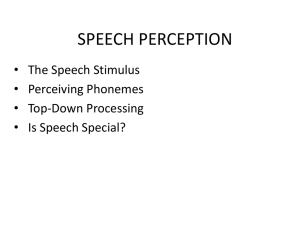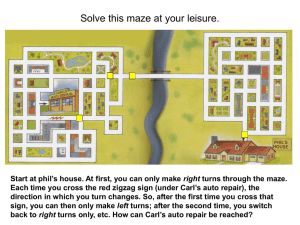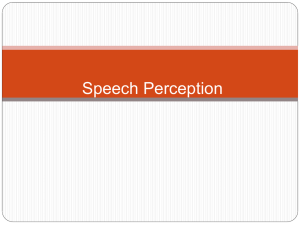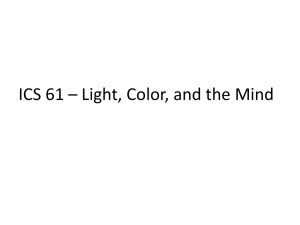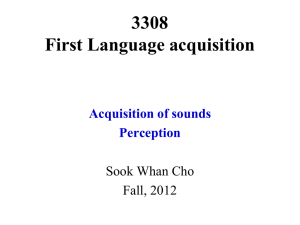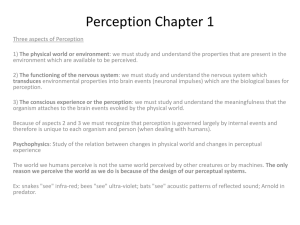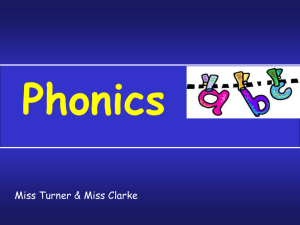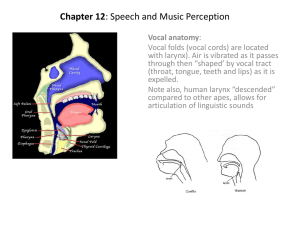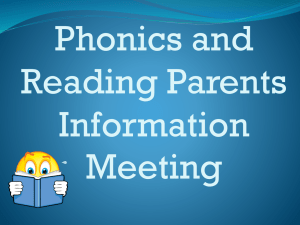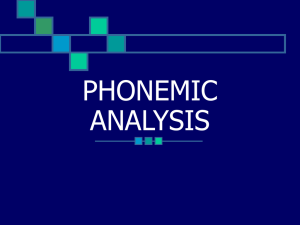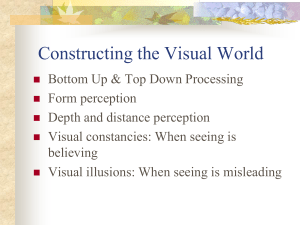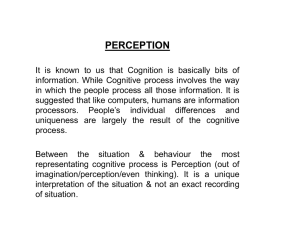Ch 13 Speech Perception
advertisement
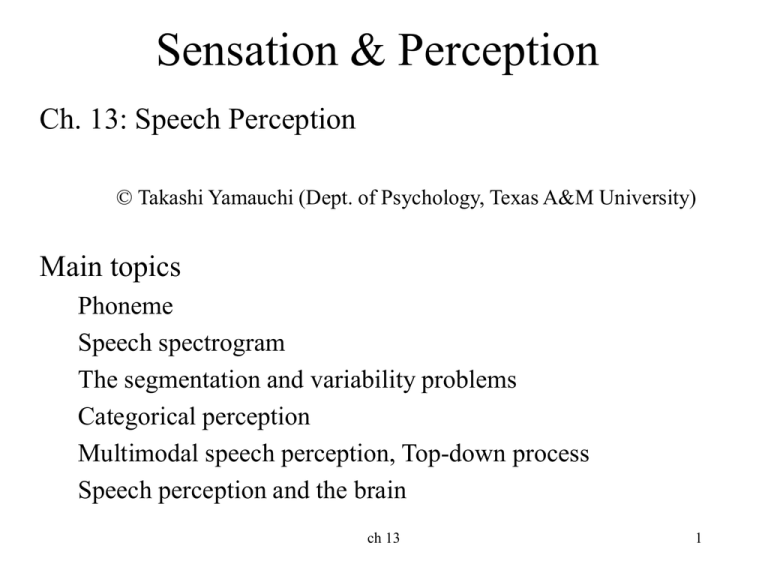
Sensation & Perception Ch. 13: Speech Perception © Takashi Yamauchi (Dept. of Psychology, Texas A&M University) Main topics Phoneme Speech spectrogram The segmentation and variability problems Categorical perception Multimodal speech perception, Top-down process Speech perception and the brain ch 13 1 • Can you understand this? ch 13 2 Visual stimuli • Units – Primary colors / 3 types of cones (short, medium, long wavelengths) – Visual features (lines, dots) – Objects (geons) ch 13 3 What are the perceptual units of speech? ch 13 4 Stimuli • Phonemes: • The smallest unit of the sound system in a language – consonants and vowels – If you change a phoneme in a word, the meaning of the word is also changed. (e.g., hip tip; cat hat; dog dig) • English has about 40 different phonemes – Every English word is produced by a combination of phonemes. • Different languages have different phonemes – E.g., Japanese does not distinguish r and l. – E.g., rice / lice; pray / play; election / erection; ch 13 5 • Babies can distinguish speech sounds initially, but lose their abilities as they learn a particular language. • Critical period and phoneme learning: 3:22 – http://www.youtube.com/watch?v=WXWGnryj EaY&feature=PlayList&p=973AED1485740C 83&playnext=1&playnext_from=PL&index=3 ch 13 6 ch 13 7 Distinguishing phonemes • Phonemes are distinguished by the way they are articulated. ch 13 8 Place of articulation ch 13 9 Manner of articulation ch 13 10 Consonants and vowels (two major phonemes) – Consonants and vowels are distinguished by how they are articulated. • Consonants obstruct air, but vowels do not. – E.g., • p, b, m, n, t, d, k, g • e, i, a, o. – Consonants differ in three primarily attributes: • place of articulation, manner of articulation, and voicing ([b] [p]). • process phonemes by attending to these articulatory features. ch 13 11 Articulation • The place of articulation – The two lips together (p, b,m,w) – The the bottom lip against the upper front teeth (f, v) • The manner of articulation – Stops: p, b, t, d, k, g – Fricatives: f, v, s, z ch 13 12 ch 13 13 • Monkeys • Can chimps learn human-like language? (4:16) – http://www.youtube.com/watch?v=utVXZAflESo • Can chimps learn human-like language? (2:38) – http://www.youtube.com/watch?v=wRM7vTrIIis&NR= 1 • Sentence • http://www.youtube.com/watch?v=2Dhc2zePJFE &feature=relmfu ch 13 14 Visualizing speech sound • /h/ Speech Spectrogram time Y-axis: frequency (Hz) X-axis: time Darkness: amplitude Time ch 13 15 ch 13 16 Some major problems in speech perception • The segmentation problem – How do we segment individual words? • The variability problem – Variability from different speakers – Variability from a phoneme’s context • E.g., /d/ differs in “dig” “dug” ch 13 17 Question: • How does the perceptual system handle these problems, and create a coherent speech perception? ch 13 18 Speech perception • How does our perceptual system handle these problems? Use other senses (e.g., visual infor.) Use background knowledge (top-down process) ch 13 19 Using visual cues in speech perception • The McGurk effect (demonstration) – http://www.youtube.com/watch?v=I1XWDOwH47Y – http://www.youtube.com/watch?v=jtsfidRq2tw&NR=1 – The "McGurk effect" was first described by Harry McGurk and John MacDonald in "Hearing lips and seeing voices", Nature 264, 746-748 (1976). ch 13 20 Using visual cues in speech perception • The McGurk effect (demonstration) – http://www.media.uio.no/personer/arntm/McGurk_english.html – What am I saying? Play the clip several times, alternating between looking at the talking head while listening, and listening with your eyes shut. Most adults (98%) think they are hearing "DA" - a so called "fused respons" - where the "D" is a result of an audio-visual illusion. In reality you are hearing the sound "BA", while you are seing the lip movements "GA". The "McGurk effect" was first described by Harry McGurk and John MacDonald in "Hearing lips and seeing voices", Nature 264, 746-748 (1976). ch 13 21 Background knowledge • Meaning and segmentation – Word segmentation is much easier if it is made in a coherent sentence. • Segmentation is affected by context and meaning – I scream you scream we all scream for ice cream ch 13 22 One phenomenon • Categorical perception – /da/ vs. /ta/ or /bu/ vs. /pu/ are distinguished by when you vibrate your vocal codes --> VOT (voice onset time) • VOT (voice onset time) – The time delay between a consonant is released and when the vibration of the vocal codes begin. • /da/ vs. /ta/ – /da/ VOT=17ms – /ta/ VOT = 91ms ch 13 23 Experiment Created artificial speech sounds (/da/ /ta/) that continuously varied in VOT. Tested the ability to distinguish the artificial speech sounds. Two sounds were presented in sequence, and Ss judged if they were the same or different. Subjects could not distinguish the sounds within the same category. ch 13 24 What does this tell? • The sensitivity to distinguish speech sounds is lost within the phonetic boundary. • Speech perception – discard physical differences, and capture them in one category??? ch 13 25 Meaning and Word Perception • Experiment by Miller and Isard – Stimuli were three types of sentences: • Normal grammatical sentences • Anomalous sentences that were grammatical • Ungrammatical strings of words – Listeners were to shadow (repeat aloud) the sentences as they heard them through headphones ch 13 26 Meaning and Word Perception - continued • Results showed that listeners were – 89% accurate with normal sentences – 79% accurate for anomalous sentences – 56% accurate for ungrammatical word strings ch 13 27 Speech perception and the brain • Broca’s area • Wernicke’s area ch 13 28 Speech Perception and the Brain • Broca’s aphasia - individuals have damage in Broca’s area (in frontal lobe) – Labored and stilted speech and short sentences but they understand others • http://video.google.com/videoplay?docid=917893658127 6081395&q=Broca%27s+aphasia&total=6&start=0&nu m=10&so=0&type=search&plindex=0 • Wernicke’s aphasia - individuals have damage in Wernicke’s area (in temporal lobe) – Speak fluently but the content is disorganized and not meaningful – They also have difficulty understanding others • http://video.google.com/videoplay?docid=759091416818 7986085&q=Wernicke%27s+aphasia&total=3&start=0& num=10&so=0&type=search&plindex=0 ch 13 29 Experience Dependent Plasticity • Before age 1, human infants can tell difference between sounds that create all languages – Japanese infants can distinguish /r/ and /l/. – Japanese adults cannot. • The brain becomes “tuned” to respond best to speech sounds that are in the environment • Other sound differentiation disappears when there is no reinforcement from the environment ch 13 30
